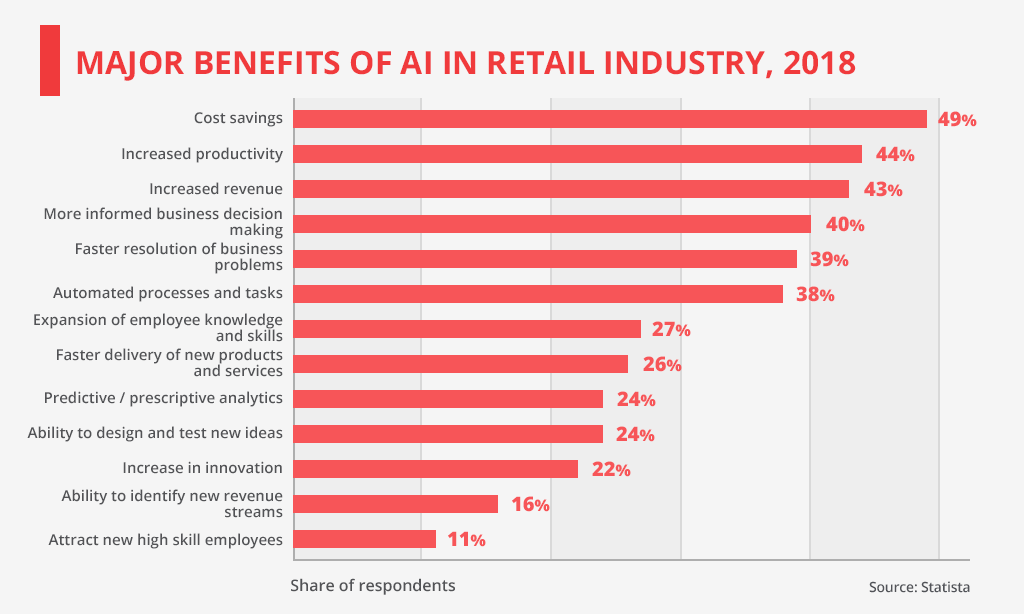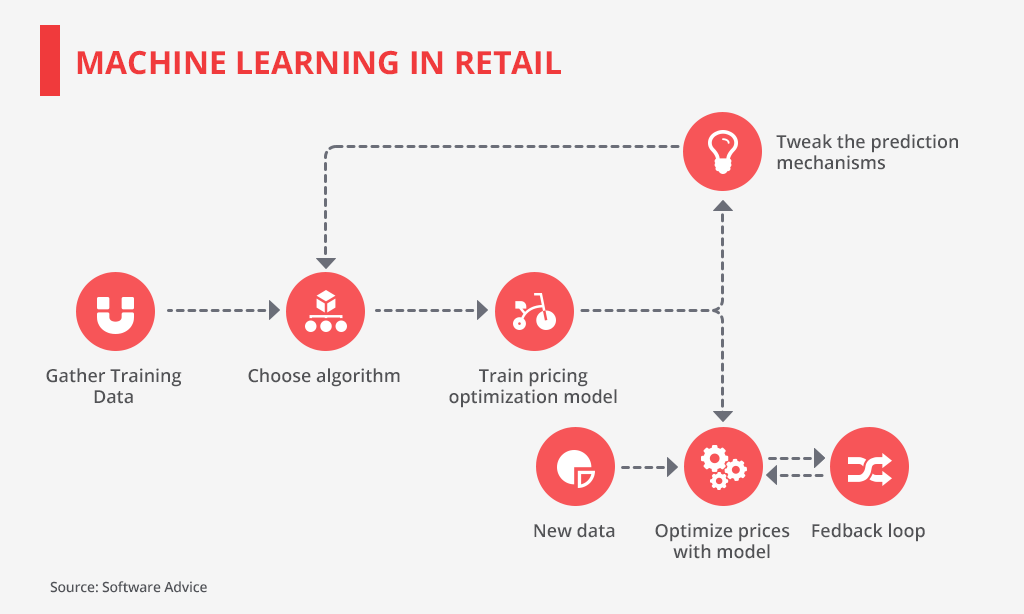How Artificial Intelligence, Machine Learning, and Big Data Will Shape Retail Forever
So far, almost half of all retailers have noticed that artificial intelligence (AI) and machine learning save costs in retailing. In addition, PointSource has detected that the presence of AI leads half of the consumers to make more frequent purchases and 34% of them are ready to spend more money.
Gartner predicts that by 2020, at least 60% of companies working across e-commerce will use AI.
How can SMB benefit from AI technology? Is it worthwhile to implement machine learning (ML) algorithms in e-commerce?
Let’s start with the definitions that will help you to understand how AI, machine learning technologies, and big data work. Then we’ll move from the benefits of ML for retailing to the common ML approaches used there.
Let’s dive right in.
What Is Artificial Intelligence, Machine Learning, and Big Data?
AI is intelligence demonstrated by machines. In retail, the biggest interest lies in a subdomain of AI that automates data analysis, ML.
ML modules that use extremely large data sets are said to be built on top of big data.
How Can ML Impact Your SMB?
There are a variety of realms that can be improved with ML, with revenue-centric ones on top of the list.
Let’s focus on the major benefits.
It Simplifies Strategic Business Decisions
Considering the large volume of incoming parameters, choosing the right price becomes difficult. ML can help with real-time pricing optimization. It allows for setting up a price that will maximize profit, stimulate selling during a week or faster, or even differentiate consumers according to their location, competition, weather, season, or operating costs.
ML starts with collecting training data.
Analysts then choose the predictive model that will be the foundation of forecasts and recommendations. This is the core of ML.
Once the model is trained, incoming new data is analyzed by the model to set up dynamic pricing, streamline product search results, or personalize the consumer experience.
Even in 2016, 9 of 16 ecommerce websites showed different prices for different people.
Case Study. 71% of all the products sold by Amazon change their prices automatically multiple times per day.
The service CamelCamelCamel allows monitoring of the historic price for a product. If you investigate the price alterations for any item, you will see how unstable they are.
It Advances Customer Support
How quickly can humans react to consumers’ queries? AI can do this immediately.
According to Gartner, by 2020, 85% of customer interactions will be without any human component.
Millennials are already influenced by this trend. So far, 43% of them are ready to pay a premium for products with hybrid support, i.e. AI with a possibility to switch to a human, as compared to a human-only service.
Case Study. Amtrak, the National Railroad Passenger Corporation, launched the AI-led chatbot Julie that boosted e-bookings by 25% and revenues by 30%.
It Improves Consumer Shopping Experience
Results of Salesforce’s survey say that nowadays, 67% of customers expect a high-quality shopping experience more than ever before. 76% of consumers call for retailers that understand their expectations and needs.
Sean Connell, the chief technology officer at the Boston-based customer experience agency Verndale, affirms that most customers interacting with an online retailer don’t realize that an AI-powered engine is running behind the scenes. “A savvy customer may realize AI is being used because they are starting to get more pertinent information/offers that are more relevant to them. They will likely engage more if this is the case, and more engagement means more accurate data,” he said.
Case Study. Once Amazon acquired the robotics company, Kiva, the retailer reduced its “click to ship” cycle time from 60-75 minutes to only 15 minutes. This allowed increasing store stock and inventory management capacity by as much as 50% while operating costs declined by approximately 20%.
It Personalizes Offers and Recommendations
Companies that don’t know their consumers risk losing them forever. Consumers who see personalized offers are twice as likely to view them. Points of information include personalized product recommendation or emails based on the customer’s purchase history, retargeted offers, etc.
Case Study. In 2016, 1-800-Flowers.com launched an AI-powered gift concierge, Gifts When You Need. By analyzing customers and their choices, the service chatbot made personalized recommendations for all website visitors. As a result, in only two months, consumers completed 70% of their online orders based on service recommendations.
It Upgrades Searchability
ML makes visual searches more efficient. It analyzes the behavior of visitors, clusters them accordingly, and provides a newcomer with the most appropriate search results.
Case Study. Amazon’s recommendations engine accounts for 35% of the retailer’s total sales. It offers products based on the tastes of similar visitors and favors products that are usually bought with a viewed item.
It Enhances Security
Fraud is an immense problem for ecommerce businesses. Credit card, refund, and chargeback frauds are listed in the top three.
Experian noticed that 63% of businesses observe the same or a similar ascending trend for fraud losses. However, 67% of fraudulent transactions remain undetected.
Case Study. PayPal’s anti-fraudulent transaction mechanism launched in 2013 and allowed the company to reduce the fraud rate to only 0.32%, which is 1% less than, on average, ecommerce sites.
Major Approaches to Machine Learning in Retail
Unfortunately, there are no recommendations on which ML models to use because in every single case, different models will show better predictions.
Let’s analyze the top 3 methods in detail.
Classification and Regression Trees
Decision trees are built in the binary format with every single leaf node responsible for a “yes” or “no” outcome.
Such models are easy to train, and they are quite accurate for problems that don’t need separate data preparation.
Bagging and Random Forest
A forest is an advanced approach to decision trees. In this case, many separate trees are built based on different incoming parameters. Once a new decision needs to be taken, every tree makes its own analysis, and the final result is set up as an average of the given results. 
K-Nearest Neighbors (KNN)
The KNN algorithm allows for distinguishing visitors by their incoming parameters, such as age, sex, location, purchase history, etc. It clusters people and predicts their behavior, accordingly.
For instance, if the model found similarities between the newcomer X and visitors A, B, and C, it would offer X the same stock that visitors the model already knows found interesting.
Wrapping-up: What Kind of AI-powered Services Will Drive Ecommerce?
Based on the latest trends in retail, it is expected that the majority of retailing companies will implement ML in their processes.
Retailers are expected to alter their prices according to their goals multiple times a day.
They will set up ML-powered chatbots to improve customer support, offer personalized products, and work on shopping experience enhancement.
In addition, AI is expected to be implemented in fraud preventing mechanisms.
The bigger the retailer is, the more ML-driven technologies it will use.
At Innovecs, we focus on solutions using big data on top of ML. For instance, one of our latest projects allows maximizing inventory capacities by optimizing used pallet space.
If you believe you need help with developing your own solution, feel free to contact us.